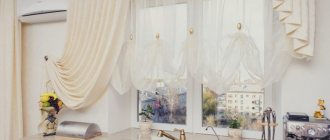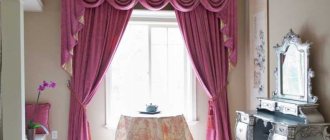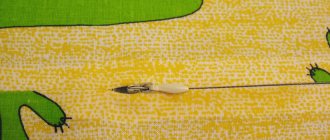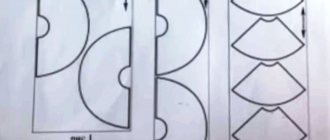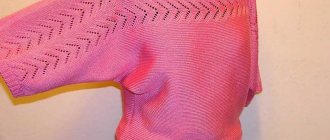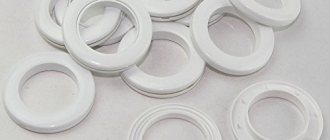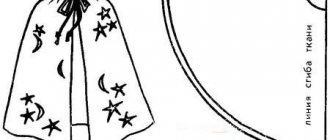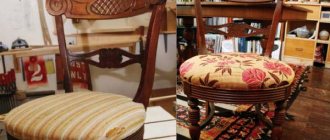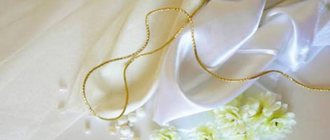Tulle is a thin drapery used to decorate windows. This is a very popular way of decorating both residential and office premises today. Detailed instructions on the topic “We sew tulle with our own hands” will tell you about the main nuances and difficulties of sewing such an item yourself.
Tulle is an essential detail of a classic window.
Sewing tulle with your own hands will be cheap, and the product can be made in an exclusive version.
Briefly about DIY sewing for the kitchen and other rooms
The new tulle drapery looks great in any room. Sewing tulle will not be difficult if you have at least minimal sewing skills, and in some cases, a suitable pattern.
Many people are not familiar with the technique of sewing tulle, although even a person ignorant of sewing curtains can complete the simplest model.
If you have beautiful fabric, then it is quite possible to master sewing tulle with your own hands.
First you need to decide on the fabric - transparent, translucent, dense, it can be:
- organza;
- chiffon;
- veil;
- net;
- muslin.
The color of the material must be selected so that the finished item fits well into the existing design of the room. In addition to textiles, you will need curtain tape, loops or eyelets of a diameter suitable for the cornice, and threads to match the fabric.
The curtain model for sewing should be chosen strictly in accordance with the style direction of the room.
Focusing on the characteristics of the current interior design, you should clearly decide on the color of the tulle.
How to calculate fabric consumption for a curtain
Independent calculation of the amount of fabric required for sewing curtains includes three stages.
Determine length
First, the finished length of the future product is measured. To do this, you need to determine what the curtain should be:
- to the floor without touching. In this case, 1-2 cm are removed from the floor to prevent rapid wear;
- to the floor and lie on it like a train. Usually the train is made 5-10 cm;
- to the windowsill;
- 10 cm below the window sill, but not reaching the floor.
You might be interested in this: The best options for beautifully hanging tulle on windows
Curtain to window sill
You also need to determine how the curtain will be attached to the cornice. For example, to sew a curtain with eyelets, add 10-20 cm of interfacing tape to the length of the curtain itself.
Note! To the result obtained, add 5-8 cm for “shrinkage” and 2 cm on each side for processing the edges.
Define width
The width consumption is determined by adding three parameters:
- cornice width;
- assembly factor;
- allowances.
The gathering factor for tulle is 2-4, the allowance is 2 cm on each side.
Calculate the amount of fabric
If separate curtains are made, then for tulle with a pattern, two step lengths of the pattern are added to the length to make the curtains symmetrical.
Calculate the length of the tulle
Examples of sewing tulle with your own hands, types
How to sew tulle yourself? To do this, it is better to turn to numerous master classes or relevant literature on cutting and sewing. First, measure the width of the window, the height from the floor to the cornice. The fabric is taken one and a half to two times more in width, and in length - just enough to make seam allowances.
The first step is to correctly calculate the length and width of the fabric.
A simple idea for sewing tulle.
- First, you need to process the top and side edges with a double hem, stitching five to seven mm. from everyone. The bottom is bent by 10-15 mm.
- Sew the curtain tape on top with a double seam and carefully pull it so that the product fits exactly the size of the cornice.
- The curtain is tried on the cornice and, if necessary, adjusted in length and width, after which it should be ironed with a not too hot iron.
- Now the curtain can be hung.
The height of the ceiling is measured from the eaves to the floor line.
When attaching curtain tape, extreme care should be taken to ensure that the stitching never crosses the tension cord.
Advice. From leftover fabric, including old fabric, you can make original decorations for curtains - flowers, butterflies, bows, decorative tiebacks, etc.
Procedure
Before starting the main steps, you need to choose a beautiful piece of fabric and make a pattern. To smooth the fabric, wet it a little, let it dry, lay it out on a flat surface, straightening the corners. If the wrinkles and dents have not gone away, then you need to iron or evaporate with an iron, if it has such a function. If you have to iron it, you need to do it through damp gauze so as not to damage the fabric or burn it. If the fabric is new, then shrinkage after washing will still appear, do not be surprised by this.
After the curtain is ironed, you need to start marking out all the sizes that will be useful in sewing. The length and width are measured individually; it depends on the window opening, which must be carefully measured, and the room. If organza veil curtains are needed for the kitchen, then you can make the length to the window sill, and not to the floor, so that they are not large and do not absorb dust and grease in the kitchen. But Japanese-style organza voile curtains must be chosen with drapery, so that the style is complex and beautiful, decorating the room.
In other rooms, you can create the look of an elegant interior by using the length of the curtains to the floor, leaving the width of the baseboard below so that no one walks on the curtains. The width of the pattern should always be twice as long as the curtain rod on which this curtain hangs. Organza is usually combined with thicker fabrics to create a fuller look. When this is done, the length of the transparent part decreases, approximately one and a half lengths of the cornice should be taken. These standard measurements are convenient because they are universal for most windows and homes. Having measured all the edges and lines, you need to remember to add small allowances for processing - about 2-3 cm, which will be used for hems and stitching.
Article on the topic: Patchwork mosaic: do-it-yourself patchwork, pictures on paper, circle program, what is a well, photo gallery, video instructions
Sew tulle
In order for the pattern to turn out correct and then you can sew something using it, you need to make calculations and apply it to the foxes only on a flat surface, on the floor or table. Light organza is placed on the pattern only on the inside. When sewing, you should pay attention to the bottom and side lines - an angle of 90 degrees must be maintained between them. If the pattern and the curtain are divided into two parts, then you need to sew side by side in order to see whether the pattern matches or not, you need to constantly check it.
How to sew folded tulle - instructions, examples, photos
Here is an option on how to sew tulle most beautifully, decorating it with folds. The latter can be done in several ways.
Modern stores offer customers a wide range of fabrics and decorative accessories.
By showing imagination and a little craftsmanship, you can sew a stunning curtain for window decoration.
- By hand - it is advisable that there be three times more fabric than the length of the cornice. That is, when there are three cornices, nine meters of tulle will be needed. The most commonly used is the triple fold. This is done like this: measure 7 cm, make a fold to the left, fasten it, measure 3.5 cm, bend the fabric to the right, after another 7 cm - down to the left, after 3.5 cm, after 7 cm - up to the left, after 3.5 cm, up to the right, etc. Each bend is carefully secured. If there is a little less textile, then the folds are made at a distance from each other - in this option the tulle is laid in “loops”.
If you take a light fabric as a basis, for example, a fashionable material, organza, you can sew a beautiful tulle curtain.
- On curtain tape - in order to correctly lay the tulle, you need to know the gathering factor of a particular tape, which you should ask about at the time of purchase. The fabric is simply sewn to the tape, after which you pull the strings - the curtain will fall into beautiful folds. Design options here are chosen based on personal preferences - “glass”, “puffs”, bow folds, etc.
The side threads can be tied and untied to iron the curtains after washing.
Types of fabric for tulle
To choose a fabric, you need to understand how different types differ from each other. They differ primarily by production method: smooth or patterned; by color and by the raw materials used.
Curtains for the room
Depending on the type of yarn and manufacturing variations, there are the following types of fabric:
- Organza. Transparent, lightweight, but dense and rigid material that holds its shape well. It is made from polyester, but there are expensive models made from silk or viscose. Poor air permeability.
- Net. Thick fabric with holes that allow light to pass through easily. Typically made from synthetic fibers. Great for the kitchen.
- Muslin. Lightweight, soft fabric made from fine threads. It allows air to pass through well, is easy to wash and dries quickly. Silk, cotton or wool are used for production.
- Veil. A thin translucent matte fabric that is most often used to sew curtains. It is made from cotton, silk, wool or linen. Lightweight, holds its shape well, although it collects dust a lot, gets dirty and fades. Perfect for the hall.
- Gas. This type of fabric has transparent, thin and light material. Usually made of silk, but sometimes they are made of synthetics.
Types of Fabric
All of these materials can make excellent curtains. You just have to figure out how to sew beautiful tulle on the windows.
How to sew tulle diagonally
Now we sew “oblique” tulle, that is, at an angle. Here we are talking about a curtain, very short in the center and longer at the edges of the window.
Tulle, sewn with your own hands, will become not only a fashionable decoration at home, but also a source of pride for the hostess.
It is important to consider a finish that will ideally suit the design of the room.
The window and cornice are measured in length and width, then the fabric is folded in half on a flat surface and cut according to the pattern into an arch or corner. The outer sides are folded up, the inner edge is decorated with bias tape - contrasting or in the same tone as the tulle. The upper edge is attached to a curtain tape or decorated with small folds.
It is not recommended to sew curtains with a large number of decorative additions for the kitchen.
Where to start
Before sewing tulle, you need to determine its place and role in the interior. The main determining factors for tulle/tulle are the way the curtains are hung and the fabric from which they are made. These factors are to a certain extent interrelated; The connecting elements are the size of the fold and its so-called. module; more about it below.
Tulle pendants
Tulle fabrics are thin, so hanging curtains from them haphazardly is not suitable - they will soon wear out and lose their appearance. Tulle curtains hang the trail. ways (see figure):
- In the drawstring;
- On clips (clothespins) for the fabric;
- On clips or hooks for curtain tape;
- On the rings for her;
- On the eyelets;
- On hinges.
Types of tulle hangers
Backstage
Tulle on the drawstring is considered by some to create a special coziness; others - philistinism. One thing is certain: hanging on a drawstring is labor-intensive and requires particularly careful work - the sleeve under the cornice rod must be perfectly straight. The hidden drawback is the excess consumption of fabric. If, for example, the diameter of the rod is 4 cm (it is not recommended to hang tulle on a drawstring on rods with a diameter of less than 2 cm), then the allowance at the top will “come out” of approx. 80 cm; For more information on calculating fabric consumption, see below. A curtain made of tulle fabric with a drawstring wears out quickly and is difficult to slide in and out. Of modern interiors, drawstring tulle fits only into Art Deco. Folds are only small, with a modulus of up to 1.5.
Note: it is better to move the tulle on the drawstring apart by the top using a carrier - a stick with a blunt smooth hook.
For the fabric
This method of hanging allows you to get spectacular scallops at the top, but of the tulle fabrics described below, only crinoline is more or less suitable for hanging by fabric. Stronger fabrics do not form a beautiful wave, and weaker ones quickly tear. The folds are large, but have a small modulus, up to 1.5.
For the tape
Hanging by ribbon is by far the best method for tulle fabrics. Described in more detail below. Depending on the type of fabric and sewing method, it fits into any interior. Folds are possible from medium (approx. 5 cm wide in a free form, i.e. on a curtain) to the largest. The fold modulus is up to 2.5-3, depending on the fabric.
On the eyelets
A complex method, then only the suspension on grommets fits into the interiors of high-tech and minimalist styles without any problems. The difficulty is in installing the eyelets. Modern eyelets themselves are simply snapped together with your fingers, but you need to punch perfectly round holes under them, otherwise the fabric will crawl out from under the eyelet. This is done either with a special machine, or with a pair of punch-die and a hammer. The latter requires perfect skills in using a metalworking tool: the blow needs to be single, short, strong, accurate and sharp. The suspension on the eyelets gives only large folds; module - as much as the fabric allows, see below. The top of the tulle under the eyelets is covered with adhesive fabric or interlining is inserted into its fold (see below).
On hinges
The method for a fairly skilled craftswoman is complex and time-consuming. It has all the disadvantages of a drawstring hanger, but allows for large folds and therefore fits into modern interiors. The only way to organically incorporate tulle into a loft interior.
Another suspension
Hand-sewn tulle
Any of the fabrics described is suitable for sewing hand-folded tulle. In this case, the curtain tape or braid is not sewn into the top fold, and the elements of the hanging system are attached to pre-assembled and stitched folds. The monetary savings on the tape are small and the work is quite labor intensive. But, firstly, sewing with a hand fold is the best way to change old unusable tulle into a new one: tears from the hangers are hidden in the folds. Secondly, tulle, sewn with the simplest hand fold, looks original, see fig. on right; how to sew tulle using a simple hand fold, see the video below.
Video: sewing tulle with a hand fold
Secondly, fabrics such as voile and crinoline (see below) can be gathered into very beautiful goblet folds; They are usually formed from thick curtain fabrics. For sewing curtains with goblet folds, see the following video tutorial:
Video: sewing curtains with soft glass pleats
And finally, chiffon and muslin (also see below) can be gathered into spectacular bow folds. For information on calculating and assembling bow folds, see the master class.
Video: calculation and assembly of bow folds
How to make beautiful folds and assemblies with your own hands
Ruffles on tulle look beautiful in almost any arrangement. There is a quick option for creating a small assembly that requires accuracy and a trouble-free sewing machine. It is important here that the thread does not get tangled during sewing, the stitching is even and continuous, otherwise the appearance of the product will be greatly affected.
When cutting the product, the functional purpose of the room is taken into account.
Sewing tulle with your own hands can be flawless if the preliminary measurements are taken without errors.
The process of work is very simple: the fabric is folded twice by two to four cm, a line is laid a centimeter from the edge, and another one is laid one centimeter from the other edge of the hem. The thread is not secured at the edges, leaving long tails. When both stitches are completed, you need to pull the loose ends of the threads, evenly distributing the folds. When the process is completed, another stitch is made between the top and bottom stitches - there is no need to tighten it.
In order for the finished product to beautifully frame the window opening, the tulle must be of sufficient length, reaching the floor.
Textile
Often tulle is called not only the fabric itself, but also all light transparent curtains. They can be made of tulle or other materials - most often organza, less often viscose and cotton.
Before you start working with light synthetic fabric (tulle, organza), carefully examine the fabric and determine how the grain thread runs. You need to cut the fabric along it. Before trimming the edges, they must be steamed with an iron.
If your material is tulle, then to make it easier to navigate, you can pull one thread from the fabric at a distance of 0.5-1 cm from the edge, and then cut along the line formed. This trick won’t work with any other fabric—you’ll have to trim it without a guide.
Synthetic tulle is very slippery, so each edge is aligned one at a time. It is advisable to place thick cotton fabric under the material so that it slips less.
Tulle for the kitchen: design options, how to sew beautiful tulle for the kitchen
The question of how best to make tulle for the kitchen with your own hands interests many housewives. It is important to consider that this is a room where the likelihood of drops of fat getting on the textiles and food stains appearing is excessively high, so the fabric should be easy to wash.
To ensure that your hand-sewn tulle beautifully frames the window opening, it is recommended to trim its edges with lace.
For the same reason, you should avoid excessive decoration and numerous folds on the curtain, giving preference to simpler forms.
Any colors are acceptable, but juicy and appetizing colors are preferred.
Sewing tulle on eyelets
Eyelets are accessories for sewing. They are metal, wooden or plastic rings that are installed on fabric. How to sew tulle on eyelets? Instructions below.
Curtains with eyelets
- pieces of fabric;
- eyelets;
- grommet tape;
- scissors;
- sewing machine;
- iron.
Important! First of all, a cuff is sewn from fabric 25 cm wide and a length equal to the width of the curtain. The eyelet tape should be twice as narrow as the fabric.
Master class on how to sew tulle with eyelets:
- Place grommet tape at a distance of 2-3 cm from the edge of the fabric and glue it, ironing it through a piece of fabric so that the iron does not stick to the tape.
- Place the tulle and fabric right sides together so that the edge with the ribbon is at the bottom. Sew.
- Iron the stitched edge towards the cuff.
- Hem the outer edge of the cuff.
- Fold the cuff in half so that the tape is between the fabric and iron. Sew along the front side.
- Finish the side edges.
Next you need to correctly position and secure the eyelets:
- Using a ruler, position the eyelet rings evenly in the center of the cuff.
- Use chalk or pencil to trace them along the inner ring.
- Using scissors, cut holes according to the marks with a small margin of 2-3 mm.
- Place the eyelet with the protrusion in the hole and “close” it with the other half until it clicks.
Examples and photos of tulle design
The original folded tulle in the photo from the Internet looks luxurious - such a voluminous product is suitable for Baroque, Empire, and classical interiors. The curtain for the bedroom is made more textured than for the kitchen.
The upper part of the canvas is treated with braid, which will create a beautiful drapery.
A combination of two or three colors, smooth and textured fabrics at the same time is very popular. The children's room is decorated with non-staining fabrics, decorated with bright prints with images of favorite cartoon characters and fairy tales.
For a child's room, it is worth purchasing curtain fabric in bright, but not overly variegated tones.
The ideal option is a plain curtain, decorated with a delicate pattern.
Decorating curtains
It’s not enough to sew tulle and curtains beautifully; you also need to decorate the fabric to your taste. At the bottom, the fringe looks good, matching the color of the main material. The style should also be taken into account so that it does not look too harsh. You can decorate tulle curtains with special ribbons and braids, only so that their width is no more than 15 cm. It is also allowed to attach lace, which should be similar in texture to the main fabric or combined in contrast.
Related article: Ornamental plants and flowers for a shady garden: how to make a flower garden in the shade
Organza window decor needs to be attached in the following ways, as it is thin and can tear:
- If the curtain is attached to the cornice with hooks or loops, then a strip with ready-made loops must be sewn in the upper part. It is advisable to choose a braid that can then be collected into drapery;
- It is better to fasten curtains to a semicircular cornice with loops; they are made of the same fabric as the canvas and match the color and material. The pattern for such a fastening is made at the rate of 15 cm on the front side plus allowances. Calculations are made based on the size of the cornice.
We sew tulle with our own hands: master class
When decorating a window opening, the correct choice of tulle can play an important role. It is not only one of the decorative elements, but also protects the room from bright sunlight, dust and various living creatures, as well as fading of furniture, without reducing the level of lighting in the room. But, despite the fact that the choice of ready-made tulles today is quite large, sometimes it is not possible to find an option suitable for all parameters. And it is at this moment that the question arises of how to sew tulle yourself, while knowing exactly what the finished product should be like.
Fabric selection
Tulle can be sewn from various types of fabric, most often used as:
- veil is a light and transparent fabric that drapes well and fits into soft folds. The disadvantage of this type of material is its airtightness;
- Organza is a stiffer material with a slight sheen. It does not drape as easily as a veil, but at the same time it holds the shape of the folds well. Just like the veil, it allows air into the room very poorly. More on this topic: organza curtains and tulle
- mesh is an elastic fabric formed by threads, between which there is a fairly large space, thanks to which it allows air to pass through well;
- muslin is a transparent fabric that reflects heat rays and allows air to pass through. The disadvantage of muslin is that it practically does not form folds.
When choosing a material, it is necessary to take into account all its properties and their use in a particular room. For example, it is not advisable to hang tulle made from organza or veil in a children's room or bedroom, since these materials do not allow the room to be fully ventilated. For rest rooms, it is best to use a mesh, which, although it has a fairly simple appearance, will ensure good air circulation when the window is open. If this type of fabric seems too “boring”, then you can beautifully decorate it yourself using rhinestones on acrylic glue, appliqués made of dense heavy fabric and other elements. You can decorate tulle very effectively using scraps of the fabric from which it is made.
So, even small-sized scraps can be used to create bows, which will subsequently be sewn to the product. If the remaining flaps are not very tall, but their width is equal to the width of the tulle, then a lambrequin can be sewn from them.
